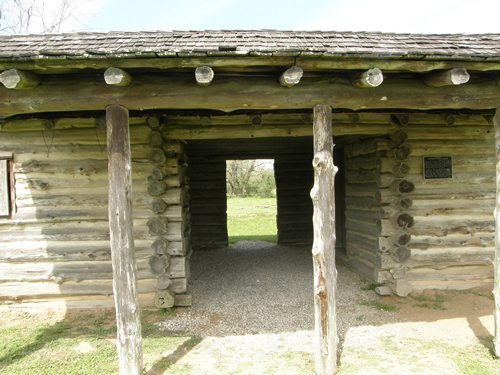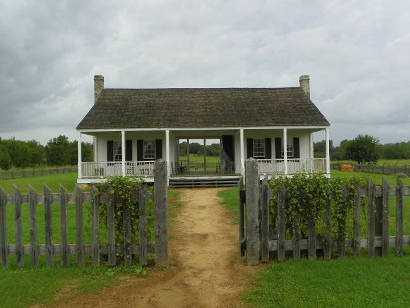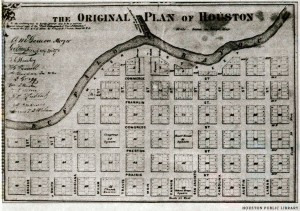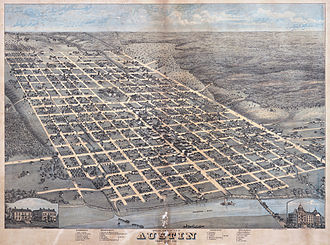|
Books by
Jeffery Robenalt
|
|
During
the unrest and confusion of pre-Revolution Texas and the establishment
of a new and independent republic,
the capital of the Republic of Texas shifted locations several times,
from San
Felipe de Austin, the capital of Stephen F. Austin’s original
colony, to the present-day capital city of Austin,
a town created for the sole purpose of serving as the Republic’s seat
of government. In between these historic sites, Washington-on-the-Brazos,
Harrisburg, Galveston
Island, Velasco,
Columbia
and Houston all held the
distinction of the being the Republic’s lead city, if only for a brief
moment.
San
Felipe de Austin was founded in 1824, near the site of John McFarland’s
ferry where the Atascosito Road connecting San
Antonio and Louisiana crossed the Brazos River. By 1835, San
Felipe had become the second largest town in colonial Texas with
a population of around 600. Stores offering merchandise imported from
the United States and inns and taverns providing lodging and meals
offered travelers their only respite across a wide wilderness that
stretched from Nacogdoches
to San Antonio. In
1829, one of the colony’s first newspapers, the Texas Gazette,
began publication in San
Felipe. The newspaper published the first book ever printed in
Texas. |
 |
|
San
Felipe was also the center of political activity during the
events leading to the Revolution. The “People of Texas” met in session
there three times to protest Mexican policies and eventually consider
breaking free of Mexico; first at the Conventions of 1832 and 1833
and finally at the Consultation of 1835. San
Felipe also played a key military role in the Revolution. After
the disaster at the Alamo,
Santa Anna ordered his armies to converge on San
Felipe. The Texas army commanded by Sam
Houston retreated from Gonzales
to San
Felipe as the Texas settlers fled east in what became known
as the “Runaway
Scrape.” On March 29, 1836, Houston
ordered San
Felipe put to the torch to deny Santa Anna’s army a source of
supply. McFarland’s ferry was also destroyed. Unable to cross the
Brazos River, Santa Anna was forced to turn southeast toward the
fate that awaited him at San
Jacinto.
Many of San
Felipe’s colonial residents failed to return to the area after
the Revolution, and the town never regained the prominence it had
once held prior to its destruction. With the formation of Austin
County and San
Felipe’s designation as the county seat, the town at least remained
a center of local government for a time. However, the Texas government
did not return, and within a decade the county seat was moved to
Bellville. San
Felipe remained a small rural community well into the Twentieth
Century, taking more than 150 years to regain the population it
had held prior to the Revolution.
On March 1, 1836, the scene of the capital shifted once again to
Washington-on-the-Brazos.
There the Convention of 1836 met and adopted the Texas Declaration
of Independence on March 2. The delegates also wrote a Constitution
and selected an ad interim government headed by President David
G. Burnett. The Convention adjourned on March 17 when a report reached
town that Mexican cavalry had occupied Bastrop
only 60 miles distant. The news created panic. In the words of one
distraught delegate, the Texans were “hourly exposed to attack and
capture, and perhaps death.” The newly created provisional government
soon packed up and fled 70 miles eastward to the new site of Harrisburg
located on Buffalo Bayou.
|
 |
For the next
three weeks the Mexicans continued in hot pursuit and the capital
of the Republic was anywhere that President Burnet happened to hang
his hat. On April 14, Santa Anna reached Harrisburg only to find that
Burnet and his government had escaped the previous morning on the
steamer Cayuga. The steamer headed down Buffalo Bayou to the
San Jacinto River and the town of New Washington on Galveston Bay.
The water route to New Washington followed many twists and turns,
but the town was only twenty miles distant by land, so Santa Anna
immediately dispatched a troop of dragoons in hopes of capturing Burnet.
The Dragoons arrived in time to see the President and his fledgling
government escape by rowboat to a schooner that would take them to
Galveston Island the next stop on the capital carousel.
President Burnet soon moved the capital to Velasco
where he negotiated with General Santa Anna who had been captured
by Sam Houston
at the Battle of San Jacinto.
The negotiations produced two treaties, one public and one secret.
The capital remained in Velasco
until October when Burnet declared the small Brazoria
County town of Columbia
the capital city. The newly elected Texas legislature met there for
the first time on October 3, 1836, however many Texans complained
that Columbia
was too small and isolated to serve as the capital. They demanded
a new location, and John and Augustus Allen provided an answer to
the dilemma.
The Allen brothers arrived in Texas from
New York in 1832. John was young, bright and fresh and soon became
an influential Texas senator. The dour Augustus was a bookkeeper who
provided the partnership with financial expertise. In 1836, the brothers
acquired a tract of land on Buffalo Bayou not far from the former
town of Harrisburg which had been burned in the Revolution. They named
the site in honor Sam
Houston in hopes of gaining his support in the search for a new
capital. The Allen brothers promoted their town by declaring “Houston
is located to command the trade of the largest and richest portion
of Texas.” As an incentive, the Allen’s offered to build a new capital
building to house the government at their expense. The offer was too
good for Congress to turn down. |
|
|
John Kirby Allen
Wikimedia Commons |
The capital building
was still unfinished in April 1837 when the government moved from
Columbia
to Houston, but Congress
convened without further delay. Lured by the promise of government
business, merchants and craftsmen began to flock to the site of the
new capital. Log cabins and structures of all varieties began to spring
up everywhere on unplanned streets, but not near enough of them to
accommodate the flood of new settlers. The Houston Telegraph reported
“This city is increasing with a rapidity unequaled by that of any
city in Texas…” Unfortunately, many of the newcomers were far from
desirable citizens. Stephen F. Austin’s cousin Mary Holley jokingly
wrote that the attraction of the riff-raff to Houston
may well be a blessing. It “concentrates the rascals, with the government
and its hangers-on, & leaves the rest of the people in peace.”
Unfortunately, the spread of disease was inevitable with so many people
crowded together in an area without adequate sanitary facilities.
People initially fell sick from drinking foul water straight from
the bayou, but that problem was solved when Congress invested $500
in the construction of cypress cisterns to collect fresh rainwater.
The city’s founder John Allen died in 1838 of what was most likely
yellow fever and 240 citizens perished in an epidemic the following
year. In spite of the problems, all was not darkness. There were also
encouraging signs of stability. The first school opened in 1839, quickly
followed by the first theater, a jail and a courthouse. Organizations
like the Chamber of Commerce and a local chapter of the Masonic Lodge
also sprang up. However, just as conditions were beginning to improve,
Congress began to speak of moving the capital again. |
 |
Map of early
Houston
Wikimedia Commons |
The speculation
that a new capital was in the offing was not without cause. Houston’s
marshy location on Buffalo Bayou, the nearly unbearable summer humidity,
the presence of yellow fever and other disease and the inadequate
accommodations were all ample reasons for complaint. Though many alternative
sites were discussed, one location in particular impressed Mirabeau
Lamar the Republic’s new president. He had first seen the site on
a bend in the Colorado River a few years before during a buffalo hunt.
Lamar not only admired the location for its scenic beauty, but also
for its healthy climate. He recommended the site to a five-man commission
appointed for the purpose of selecting a new capital, and after an
appraisal, the commission approved his recommendation.
The opponents of the new site complained that it lay too far to the
northwest in the “middle of nowhere.” In addition, they protested
that the location bordered on the Comancheria and would require constant
defense from the dreaded Comanches. The protests were also joined
by the citizens of Houston,
who were worried that their city would wither on the vine if it lost
the prestige of being the capital. However in spite of the protests,
Congress voted to approve the new location and named it Austin
in honor of the “Father of his Country,” Stephen
F. Austin. The government then demonstrated that it had learned
a lesson from the mistakes made at Houston
by appointing Edwin Waller to take charge of developing the new capital. |
 |
An 1873 illustration
of Edwin Waller's layout of Austin
Wikimedia Commons |
|
Waller, a signature
of the Declaration of Independence, was born in Spotsylvania County,
Virginia on November 4, 1800. He represented Columbia
at the Consultation of 1835 and served as a delegate from Brazoria
to the Convention of 1836. As a member of the convention, he served
on the committee that framed the Republic’s Constitution. Determined
to develop a town the Republic would be proud to call its capital,
Waller proceeded with honesty, foresight and meticulous care. Under
his supervision, a team of surveyors led by L. J. Pilie and Charles
Schoolfield carefully laid out a town on the north bank of the Colorado
River that was divided by a broad central boulevard named Congress
Avenue and bordered by Waller Creek on the east and Shoal Creek
on the west. The thoughtful design would allow Austin
to expand gracefully, unlike the helter-skelter sprawl that had
hampered Houston. Waller
also sold 306 choice building lots at auction for the benefit of
the Republic of Texas instead of some greedy speculator.
Construction on the capital began in May1839. The first thing Waller
did was build an eight foot stockade to surround the one-story frame
capitol building set back from Congress Avenue on a hill at what
is now the corner of Colorado and Eighth streets. Comanches were
known to roam the streets at night and every now and then a careless
citizen would lose their hair. A local politician reported that
“You were pretty sure to find a congressman in his boarding house
after sundown.” The site had been incorporated in1839 under the
name of Waterloo, but shortly thereafter the name was officially
changed to Austin. By
1840, the capital was beginning to spread outward from Congress
Avenue and the 856 residents of the city elected Edwin Waller to
the office of mayor for the valuable services he had rendered.
Unfortunately,
the city of Austin had
a very influential enemy, Sam
Houston. Houston
often described the new capital as “the most unfortunate site on
earth for a seat of government.” When he was reelected to the presidency
in 1841, he refused to move into the official residence, preferring
instead to take a room at a boarding house run by Mrs. Angelina
Eberly. Then in February 1842, Houston
saw his chance to return the capital to his namesake. A Mexican
force of 1000 troops under the command of General Raphael Vasquez
invaded Texas and occupied San
Antonio. Fear quickly spread that the troops would soon move
on the capital, and the President, arguing that the city was defenseless
against attack, ordered a special session of Congress to meet in
Houston. He also ordered
the secretary of state to remove the government archives to Houston.
Knowing that as long as the government archives remained in Austin
the city would be recognized as the official capital, the citizens
of Austin banded together,
formed a vigilante “Committee of Safety” and warned the government
officials who remained in the capital that any attempt to remove
the archives would be met with armed resistance. When his attempt
to revive Houston as
the capital failed, Sam
Houston compromised by ordering Congress to meet at Washington-on-the-Brazos
where the Declaration of Independence had been signed in 1836. After
the government was established, Houston
sent Captain William Pettus to collect the archives, but when Pettus
rode into Austin, the vigilantes lopped the mane and tail off his
horse and sent him back to Washington-on-the-Brazos
empty handed.
Frustrated, President Houston decided to dispatch Captain Thomas
Smith to make off with the archives under the cover of darkness.
Late in the evening of December 30, 1842, Mrs. Eberly, whose boarding
house business would suffer if the capital was moved, spotted Captain
Smith loading the archives into a wagon. She ran to the top of the
hill on Congress Avenue and touched off the cannon that stood in
front of the stockade surrounding the capitol building. The blast
aroused the town, and an armed posse of vigilantes ran Smith down
at Brushy Creek and retrieved the records. The vigilantes threatened
that anyone else who tried to steal the records would be shot.
The “Archives War” ended with Captain Smith’s failure, and Sam
Houston made no further attempts to move the records. For the
next several years, Austin
had more than its share of troubles with the population declining
to a modest 629. However in spite of the problems, a general election
held in 1850 voted overwhelmingly for Austin
to become the permanent capital of Texas. By the end of the 1850’s
the population had risen to a comfortable 3,494.
© Jeffery
Robenalt
"A Glimpse of Texas Past"
August 1, 2013 Column
jeffrobenalt@yahoo.com
|
References
for "The Capitals of Texas"
|
|
Davis, William
C., Lone Star Rising, (Simon and Schuster, 2004).
Fehrenbach,
T.R., Lone Star: A History of Texas and the Texans, (Da Capo
Press, 2000).
Grisham, Noel,
Crossroads at San Felipe, (Burnet, TX: Eakin Press, 1980).
Humphrey, David
C., Austin: An Illustrated History, (Northridge, CA: Windsor,
1985).
Humphrey,
David C., "AUSTIN, TX (TRAVIS COUNTY", Handbook of Texas Online
(http://www.tshaonline.org/handbook/online/articles/hda03), accessed
April 2, 2013. Published by the Texas State Historical Association.
Jackson, Charles
Christopher, "SAN FELIPE DE AUSTIN, TX", Handbook of Texas Online
(http://www.tshaonline.org/handbook/online/articles/hls10), accessed
April 8, 2013. Published by the Texas State Historical Association.
Johnson, John
G. "CAPITALS", Handbook of Texas Online (http://www.tshaonline.org/handbook/online/articles/mzc01),
accessed April 8,2013. Published by the Texas State Historical Association.
McComb, David
G., Houston, a History, (Austin, TX: University of Texas
Press, 1981).
McComb, David
G., "HOUSTON, TX", Handbook of Texas Online (http://www.tshaonline.org/handbook/online/articles/hdh03),
accessed April 14, 2013. Published by the Texas State Historical
Association.
|
|
|
